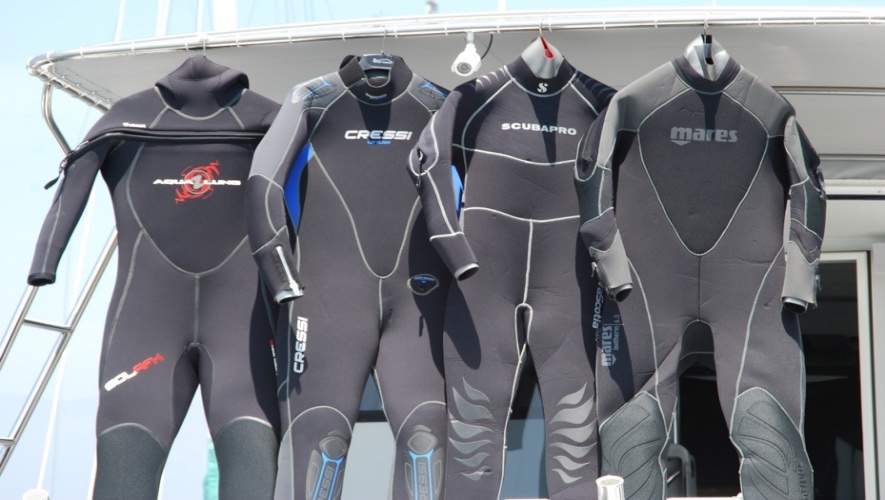When you think about diving it’s usually assumed that you will need to wear a wetsuit. Yes, that cumbersome, highly compressive wetsuit. While they might be difficult to put on, wetsuits serve a purpose on dive trips. They help keep divers buoyant and also protect them from cold waters.
Wetsuits keep divers buoyant which neutralizes them in the water allowing them to hover rather than sink or float. They also keep you protected from cold waters and help regulate body temperature during longer dives. Wetsuits also reduce drag while swimming which helps divers move more smoothly in the water.
Body Temperature
A properly fitted wetsuit will help to keep your body temperature regulated and normal. Divers should feel comfortable and relaxed during dives and this includes a warm body temperature. It’s extremely frustrating to have to end a dive early because you are cold. Wetsuits help to reduce this and also allow divers to do on deep dives in cold waters.
There is a difference between wetsuits used for surfing and the ones used for diving. The diving variation is made of a special type of neoprene rubber that does not compress. This is important because the thickness of the wetsuit is what determines the level of thermal insulation. Deep dives in cold waters will require wetsuits of at least 7 mm (0.27 in) thick while warmer waters and shallow dives only need 3 mm (0.11 in) thick wetsuits.
Protection
Westsuits keep your body protected from cold waters but they also keep divers skin protected from abrasions. The ocean if an entire world all in itself and there are definitely harsh elements that divers can encounter. Even a slight brush up against some coral or rock can result in a scrape or cut. Wearing a wetsuit offers a layer of protection from possible injury. They also help reduce the risk of a sting or bite from sea life such as jellyfish, eels, or sea urchins.
It should be noted that getting injured while diving is extremely rare and a bite or sting is usually the result of sea life being provoked. It’s important to remain respectful while diving and never stick your fingers into dark crevices. Always be aware that many sea creatures camouflage themselves or bury into the sand.

Buoyancy
Divers use buoyancy control to maneuver within the water and control their body direction. It also enables divers to pause and remain still either during safety stops or while looking at something. Wetsuits help to make finding and neutralizing buoyancy easier which makes dives more relaxing.
Buoyancy determines whether an object will float, sink, or hover and it is actually an important diving skill that is often overlooked. When in a state of neutral buoyancy a diver will hover and remain suspended in the water. Several factors including wetsuits contribute to buoyancy. This is why divers should choose the correct wetsuit and understanding the effect it has on a dive.
Tip:
Keep in mind that the thicker a wetsuit is the more buoyant you will be. This means that thicker wetsuits will usually require a heavier weight belt for descending. If you are unsure about which weight to use simply ask the divemaster or dive shop for specific recommendations.
Swim Speed
Wearing a wetsuit reduces drag in the water while increasing swim speed and efficiency. It’s essential for divers to preserve their energy and maintain regular breathing. Wetsuits help divers achieve this by allowing them to swim more efficiently with less effort. In fact, when tested against non-wetsuit wearers, wetsuits actually save you 5-10 seconds for every 328 feet (100 meters) of swimming. It might not seem like a lot but all that time, effort, and energy really save in air usage.
Tip:
Always make sure that your wetsuit fits tight and feels like a second skin. You want to have it tight on the body to reduce water and air bubbles which can make it harder to descend and also create resistance while swimming. If you ever feel like you are having trouble descending try pulling at the collar of your wetsuit to open it and release any possible air bubbles.
Options
There are many benefits to wearing wetsuits while diving however, they are not always required. Wetsuits are typically optional when water temperatures are on the warmer side and the dive is relatively shallow. Sometimes it’s just a matter of preference.
It’s good to keep in mind that if you have a lower body fat percentage or get cold easily you might be better off choosing to wear a wetsuit even if the water temperatures are warm. Dives generally last anywhere from 30-45 minutes so you want to make sure you are comfortable and that your body temperature doesn’t drop too much.
Dive shops and divemasters are always great personal sources of recommendations. They will help you choose the correct suit and let you know if wearing a suit is even necessary for your particular dive.

